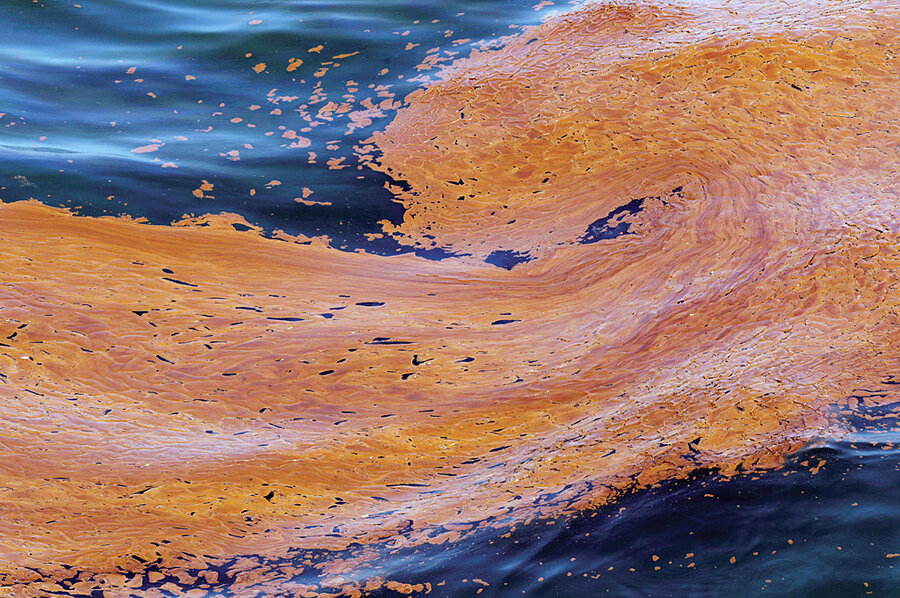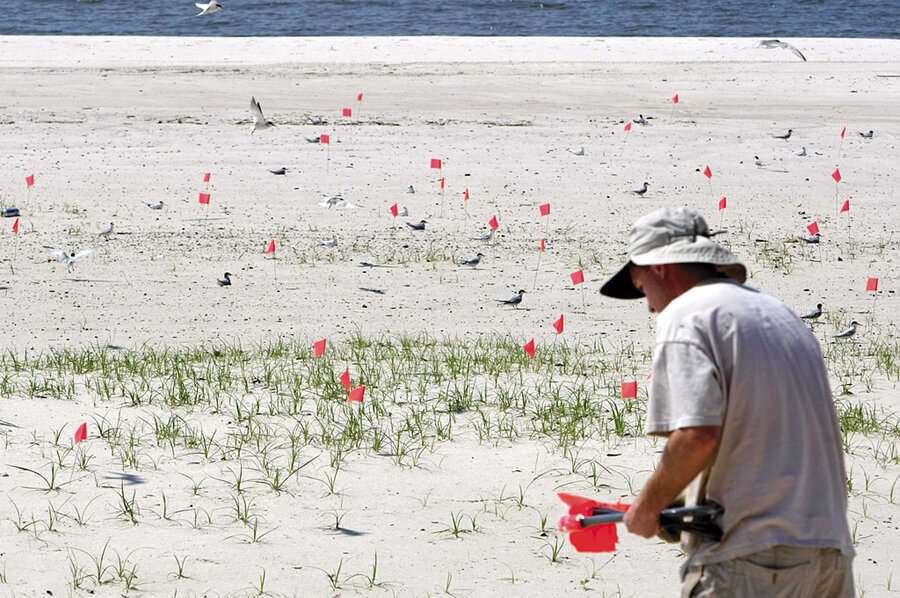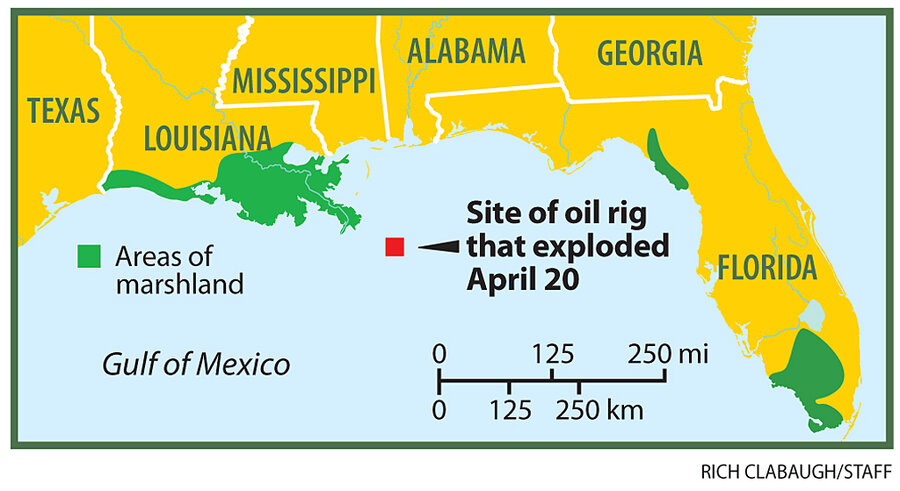Gulf oil spill's environmental impact: How long to recover?
Loading...
| Grand Isle, La.; and Boston
For four days, Myron Fischer has taken time to stroll the beach here on Elmer’s Island – a small, fragile barrier island and newly minted state wildlife refuge on Louisiana’s Gulf Coast.
Occasionally, he wades into the water to get a closer look at seabirds bobbing and drifting on the sea surface. He returns to the sand, shells cracking under his boots, and says that these patrols are “not something we do on a normal basis.”
But these have not been normal times for Mr. Fischer, director of the state’s new marine biology lab on Grand Isle.
IN PICTURES: Louisiana oil spill and Destructive oil spills
The April 20 undersea oil blowout that destroyed the Deepwater Horizon oil rig and killed 11 oil workers some 40 miles offshore has spewed more than 3.5 million gallons of oil into the Gulf so far. And efforts to slow or halt the 200,000 gallon-a-day flow have failed to this point.
On Saturday, tar balls as big as golf balls began washing ashore on Alabama's Dauphin Island, a barrier island that helps protect the entrance to Mobile Bay and some 16 miles of coastline to the west.
The blowout has been “a new challenge for everyone, for all academia, the science community, the universities,” Fischer says.
What scientists know about how oil spills can affect the environment – and for how long – is drawn from a range of past events, no two of which have been alike. It means that “the leading scientists can build a model for what they think is going to happen, but we may wake up the next morning and not know exactly what to expect,” says Fischer.
Comparisons with the Exxon Valdez spill, for example, can be misleading because of significant differences in the type of oil, the ecosystems affected, and the way natural processes break down oil.
Moreover, the uncertainty is greater in the current spill. For the most part, researchers have studied the aftermath of surface spills. The Deepwater Horizon blowout occurred at 5,000 feet, dispensing crude oil from seafloor to surface.
Many of the long-term effects may remain hidden as natural processes and chemical dispersants break up the oil into small globules dense enough to sink to the bottom. There, it has the potential to affect bottom dwellers for decades.
“This is uncharted territory in terms of assessing the effects of a spill from a deep well like this,” says Judy McDowell, a scientist at the Woods Hole Oceanographic Institution in Massachusetts.
Dr. McDowell was a coauthor of a 2003 National Academy of Sciences report that remains a seminal work for understanding the behavior of petroleum and petroleum products spilled in marine and coastal environments, many marine scientists say.
For Louisiana in particular, a key area of concern is coastal marshes. They are the breeding ground as well as home base for a wide range of marine life vital to the region’s fishing industries. Moreover, the wetlands provide a first barrier against storm surges from hurricanes.
But southern Louisiana’s wetlands already are stressed – vanishing as the Mississippi Delta sinks beneath the ocean at a rate that, by some estimates, averages 50 acres a day. In addition, the fisheries off the coast are exposed to an annual “dead zone” each spring as nutrient-rich water from the continental heartland moves down the Mississippi and into the Gulf, triggering algae blooms. When the algae die and decompose, the process uses up much of the dissolved oxygen in the water. Fish flee, but bottom dwellers – crabs and other shellfish – generally can’t move fast enough to do so.
If the blowout “turns into something that takes months to shut off ... that is our biggest concern,” says James Cowan Jr., a fisheries ecologist at Louisiana State University in Baton Rouge. With the ecosystem already distressed, “We are concerned it may be at a tipping point.”
In trying to assess the potential effect of oil on the Gulf Coast wetlands, a 1969 spill in Massachusetts’ Buzzards Bay might offer close – if still imperfect – parallels, say Dr. McDowell and Woods Hole colleague Christopher Reddy.
It opens a window on the biological processes that over time help ease the effects of the spill. But it also highlights the long-term effects that can remain after much of the surface evidence has vanished.
The spill involved the barge Florida, which ran aground, dumping 175,000 gallons of diesel fuel. The first organisms to recolonize the area were “opportunistic species” such as carbon-loving worms and microbes, McDowell says. As they ate up their carbon-rich food source – in effect cleansing the harbor of much of the hydrocarbons – they died off, making way for species that normally inhabited the harbor and its marshland to return.
Still, she says, it took about a decade before researchers began to see the kinds of organisms in the harbor one would have seen prior to the spill, such as fiddler crabs. Dr. Reddy has continued to take samples from the marsh, and some 40 years later, oil remains trapped in the sediment three to eight inches below the surface. And it has changed little chemically since its arrival.
“If you stick a shovel into the ground and lift it, you will smell diesel fuel,” he says. “And when you analyze it, it doesn’t look like it’s been significantly changed chemically. And the fiddler crabs, mussels, and marsh grasses are not as healthy” as they are at pristine sites.
Yet above ground, he adds, the marsh looks to have recovered to the point where it could grace a tourist’s postcard.
Another nearby site affected by a spill in 1974 and still under study has not fared as well. In many places, the marsh grass still hasn't returned. And when a research team looked at aerial photos of the site taken before the spill, the researchers found evidence of post-spill erosion in areas that received the most oil. The oil worked its way into the soil, killing off marsh grasses that would have stemmed the erosion.
Reddy cautions that the impact of oil spills depends a great deal on location and dose. Differences in air and ocean temperatures can play a significant role in the pace at which biological processes can begin to blunt the effects of oil.
Research efforts such as this represent a cautionary tale of another sort, according to Joanna Burger, a Rutgers University ecologist. Beware of the small numbers, as in: Only 20 percent of the wetlands have been affected.
“The problem is it’s always the 20 percent of the marsh that’s on the edge, in the intertidal zone,” she says. “That’s the most productive zone in terms of invertebrates and small fishes. And it’s where the herons and egrets feed. You might have destroyed only 20 percent of the marsh, but you might have destroyed 90 percent of the animal production.”
The point is not lost on Louisiana’s Fischer: “As we lose the coastal edge, we are losing the productivity of the area. Throughout history we have had various types of small tragedies such as freezes and pollutants, but we’ve never experienced a large case of oil intrusion into the estuarine areas. What would happen? I don’t have the answer.”
Related:
Transocean Deepwater Horizon oil rig explosion shows new risks
Ecological risk grow as Deepwater Horizon oil rig sinks in Gulf
Spread of Gulf oil spill puts fragile Louisiana Coast on alert
IN PICTURES: Louisiana oil spill and Destructive oil spills







